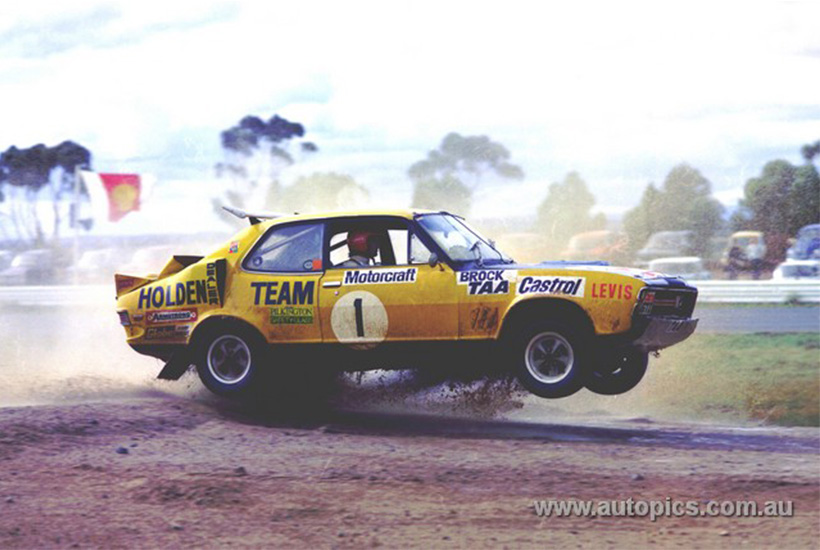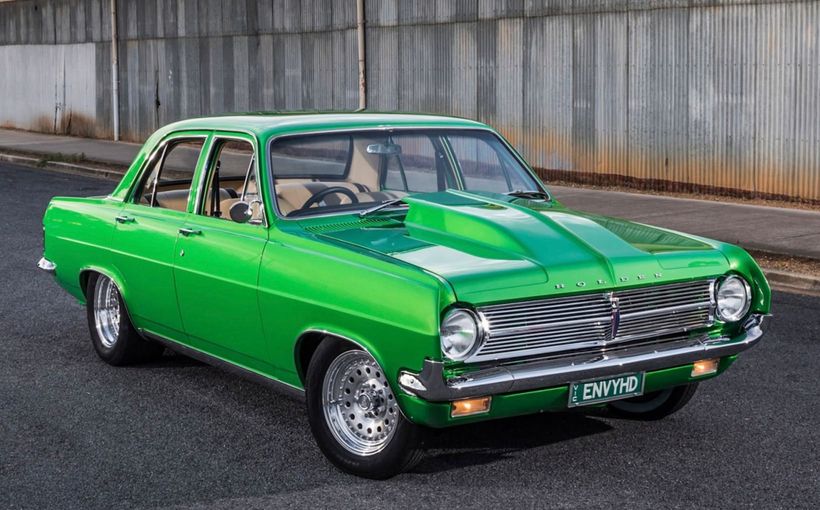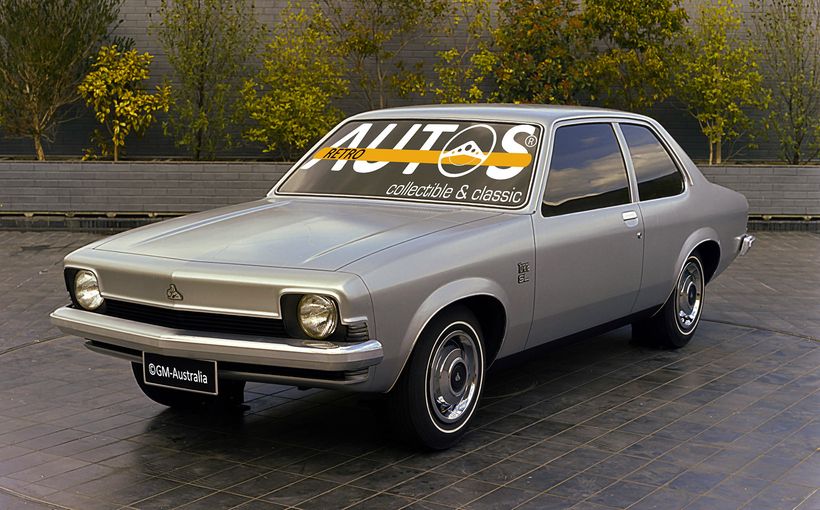
The LC Torana GTR XU-1 achieved so much in racing and rallying that the milder GTR version has tended to live in its shadow. However, the GTR was a very successful competition car in its own right that played a key role in the early careers of touring car legends Peter Brock and Dick Johnson.
The name ‘Torana’ is an Aboriginal word that means ‘to fly’. It proved to be an inspired choice by GM-H as its new six cylinder compact enjoyed sky high success in both the showroom and in competition.
The LC Torana GTR was thrust into motor sport duties soon after its launch in October 1969 and immediately proved how effective a powerful engine from a large family sedan shoehorned into a much smaller car could be.
Cleverly packaged and smartly detailed throughout, the GTR had a compact 2540 mm wheelbase, narrow 1300 mm track and athletic 1018 kg kerb weight, yet was powered by a high performance two-barrel version of the Kingswood’s 161 cid (2.6 litre) in-line six.
In this hotter 2600S form, GM-H claimed 125 bhp (93 kW) which blessed the GTR with spirited standing 400-metre times of just over 17 seconds and top speeds exceeding 105 mph (170 km/h).

With its sporty four-speed gearbox, front disc brakes and stiffer suspension, the value-packed GTR was the right car at the right time aimed squarely at the youth market.
Under the skilled preparation of Harry Firth’s newly formed Holden Dealer Team, the GTR not only achieved success as a sports sedan, rally car and rallycross competitor.
It also dutifully served as the development platform for the hotter and faster XU-1 released in July 1970, which would soon turn Australian circuit racing and rallying on its head.
LC Torana GTRs competed all over Australia from club-level racing, rallying, motorkhanas and hillclimbs right on up to the Australian Touring Car Championship and Australian Rally Championship.
So as we celebrate Holden’s original ‘pocket rocket’, here’s a selection of some of the most interesting and/or successful competition versions.

Brocky and The Beast: Supercharged for Success
The most famous and successful LC Torana GTR was undoubtedly the highly modified, supercharged example built by the Holden Dealer Team for Peter Brock to drive in the booming sport of rallycross in the early 1970s. It was nicknamed ‘The Beast’.
At the time Brock was HDT’s new recruit, plucked from obscurity racing a home-built Holden six-powered Austin A30 sports sedan that went much faster than it had any right to.
The wild-eyed, goatee-bearded rookie clearly had an abundance of raw talent, but wily team boss Harry Firth wasn’t going to make it easy for him. He knew Brock needed to serve an apprenticeship to hone his craft and learn to cope with the many expectations and pressures that came with being a GM-H factory driver.
And he reasoned the best place to do that was in sports sedans (aka sports racing closed) and rallycross, which were both one step removed from the glaring spotlight of series production racing.

The Beast started life as a stock standard LC Torana GTR wearing Victorian rego KLD 158 which Firth used as his development mule for the XU-1 that would soon follow. He replaced the standard 161 cid (2.6 litre) six with the larger triple-carbed 186 cid (3.0 litre) engine proposed for the XU-1.
Brock drove it to victory in the first Australian rallycross meeting held at Calder Park in February 1970 before Firth decided it would also make an ideal replacement for Brock’s homebuilt Austin A30 for circuit racing.
HDT was experimenting with aerodynamics of the new Torana body at the time so the GTR appeared at Sandown for a sport sedan race in April 1970 fitted with a big front spoiler and a full width, roof-mounted aerofoil.
These aero devices – particularly the rear wing - generated plenty of downforce and Brock won the race. Firth knew there was zero chance of GM-H approving such a wild device for the road-going XU-1 but the huge increase in rear wheel traction it produced planted the seed for what would become HDT’s rallycross car.

The sport of rallycross was inadvertently created in the UK in 1967, after an outbreak of foot and mouth disease in British cattle herds triggered severe restrictions on vehicle movements. This forced the cancellation of that year’s RAC Rally on the day it was due to start.
As a stop-gap measure to appease unhappy sponsors and millions of TV viewers, the event’s broadcaster ITV quickly came up with an alternative plan to stage what was effectively a rally special stage and touring car race in one at the nearby military tank testing course at Bagshot.
The rugged, muddy and multi-surfaced terrain was the ideal stage on which to see some of the world’s best rally drivers trading blows in a four-car clash that proved a real winner with TV viewers. The following year ITV backed the establishment of rallycross as a sport in its own right and it really took off, not only in the UK but other countries including Australia in the early 1970s. Calder Park in Melbourne was the first track to play host to the new sport in 1969, followed by Catalina Park at Katoomba in the NSW Blue Mountains. Both tracks had a mix of bitumen road circuit and infield dirt sections, featuring large man-made jumps and deep water splashes that created some spectacular action.
Backed with live television coverage by the Seven Network (a rarity in those days) and blue-chip sponsors like Coca-Cola and Motorcraft, rallycross in its prime attracted some top name drivers and works entries from Holden, Ford and Renault.
For Holden, it represented a golden opportunity to promote its new Torana as a fast, powerful and rugged winner.

Building The Beast
Like the team’s forest rally cars, its body shell had to be tank-tough to withstand the brutal punishment of endless high-speed jumps and hard landings.
The interior was stripped to the bone and a rigid roll cage installed. A process perfected in the rally cars was to heavily reinforce the standard Torana body shells using 3/8-inch steel rod welded internally into critical areas, particularly in known weak spots at the base of the windscreen pillars and centre roof pillars where the rally cars had shown serious cracking.
The lower body sills and other chassis members were also filled with a two-pack expanding foam product Firth referred to as ‘bread’. When injected into these cavities in liquid form, it would rapidly expand internally (like a loaf of bread) and then set rock solid to form a lightweight but extremely rigid chassis unit.
The standard Torana six was an inherently nose-heavy car, which not only caused understeer in corners but was particularly undesirable in rallycross due to the jarring nose-first landings from high speed jumps.

To address this imbalance, The Beast’s inline six was mounted much further back in the engine bay so that the front of the engine sat just behind the front axle line.
This was to get as much weight off the front wheels as possible to level out the Torana’s tendency to nose-dive in flight and improve overall front-to-rear weight distribution to reduce understeer and improve overall balance.
The engine’s single radiator was also removed from the front of the engine bay and replaced by two units mounted within a large wedge-shaped housing on the boot lid, which cleverly doubled as a rear spoiler.
These radiators were force-fed cooling air from large intakes grafted onto each rear quarter panel and an additional full-width scoop across the base of the rear window.
This relocation served two purposes; to get more weight over the rear wheels and stop the radiators getting clogged with mud or punctured by rocks thrown up by other cars.
The engine and radiators were connected by long sections of tubing mounted well out of harm’s way inside the car with a powerful electric bilge pump to keep the coolant moving freely.

The Beast was never short of grunt thanks to a very compact, three-vane, Rootes-type supercharger mounted on the left hand side of the engine, driven by the crankshaft using a simple toothed belt and pulley arrangement.
It was fed by a pair of SU single-choke carburettors breathing through a hand-made plenum chamber mounted high on the left hand side of the engine bay. This required a small housing on the side of the bonnet to provide sufficient clearance when shut.
A large hole cut in the firewall allowed the carby plenum to breathe directly from the relatively clean air inside the cabin. One can only imagine how loud the induction roar would have been on full throttle!
To maintain engine reliability the supercharger’s boost pressures were kept fairly low, but that was more than enough extra puff. According to Firth, the blower doubled the power of a standard XU-1 with a claimed 320 bhp at the flywheel and a rock-throwing 260 bhp at the rear wheels.
This also avoided the need for expensive cylinder head and intake modifications normally required to extract more power from a naturally aspirated engine. The blown 186 ran the stock bottom end and the clutch was also standard apart from a heavy-duty driven plate.
The GTR’s original Opel M20 four-speed gearbox was replaced by a stronger M21 at some stage and the rear axle assembly remained largely stock, apart from a Detroit Locker diff centre for maximum rear wheel traction.

The team experimented with different rear tyres in its endless search for more traction, which included some super wide hand-cut racing tyres and even a set of dual rear wheels at one stage.
Weighing less than 1000 kgs, this one-off lightweight competition special was a brilliant piece of home-grown engineering that proved to be very successful in the role it was specifically built to perform.
Brock dominated the 1970-72 Victorian Rallycross Series at Calder Park, which thanks to its live television coverage on black and white TV screens around the nation quickly made him a household name.
He sometimes ventured north to compete at Catalina Park (HDT team-mates Colin Bond and Larry Perkins also drove this car on occasions), but for most of its competitive life Brocky and The Beast were Calder specialists.
Sadly, after three years of boom, rallycross soon went bust. To succeed as a national sport it needed more tracks than just Calder and Catalina, but those interstate bids never got off the ground.
HDT also seemed to lose interest in the sport after Brock’s first Bathurst 500 win in 1972 and when Calder management cancelled its rallycross meets at the end of 1974 the sport’s fate - and that of the amazing HDT Beast - was sealed.

Dick Johnson’s LC Torana GTR
Long before he became a Ford racing icon and national touring car star, Dick Johnson was trying to make a name for himself racing an EH Holden in his native state of Queensland in the 1960s.
Regular wins were proving hard to come by, but that all changed in late 1969 when Johnson did a deal with the Eagers Holden dealership in Brisbane to get his hands on a brand new LC Torana GTR.
Although he took delivery a few days before Christmas, the GTR was not the favourite gift Santa left under Dick’s tree. He was less than impressed with the new Torana’s ride and handling and he knew the 161 cid engine would need a lot more power, but he was encouraged by the Torana’s potential.
Dick soon decided to stop using it as his daily driver and turn it into a full-house Improved Production race car instead. It was a fateful decision that would see his career start to take off.
When the XU-1 was released in July 1970, Johnson progressively upgraded the GTR to XU-1 specs which with the extra technical freedoms allowed under the Improved Production rules resulted in one of the fastest Torana sixes in the country.

With backing from oil company Shell and Eagers Holden, Johnson enjoyed great success in his heavily modified GTR, winning three consecutive Queensland Touring Car Championships (1970-71-72) and numerous feature race wins at his local Lakeside and Surfers Paradise tracks.
It was also during this period that he started to venture beyond state borders to measure his abilities against the best in the business. He made his Australian Touring Car Championship debut at the Bathurst round at Easter 1970 and scored his first ATCC point a few months later at Lakeside.
From there, the Queenslander’s star continued to rise as he forged closer ties with the Holden Dealer Team resulting in some dazzling guest drives of an HDT-prepared XU-1 entered by Brisbane’s largest GM-H dealer, Zupps Holden.
Johnson’s historic switch from Holden to Ford, when he started racing an XB GT Hardtop Group C touring car for Brisbane Ford dealer Bryan Byrt in 1977, was the start of an unbroken bond with the blue oval. However, he readily admits that his LC Torana GTR played a pivotal role in what became a stellar racing career.

Tony Alessi’s LC Torana GTR
Another rallycross competitor that followed HDT’s supercharged flight path into rallycross was Sydney-based Tony Alessi.
In 1972, at the peak of the sport’s popularity, he debuted a self-built LC GTR at Katoomba’s Catalina Park, resplendent in dark purple with a contrasting white roof and Globe Rallymaster alloy wheels.
Like the HDT Beast, Alessi’s Holden six was moved back behind the front axle line for better weight distribution.
He also followed the factory team’s forced induction route to gain more power, but unlike HDT’s Rootes-type blower the Alessi machine was equipped with a Shelby Paxton centrifugal-type supercharger.

The engine’s radiators were also mounted in the boot area fed by a cavernous full-width air intake mounted at the base of the rear windscreen. Like HDT, Alessi wanted to get more weight over the rear wheels to improve weight distribution and get the car’s vulnerable cooling system out of the firing line.
In its initial form the slick-looking GTR was to be equipped with an enormous roof-mounted rear aerofoil that dwarfed the HDT version (see workshop photo) mounted on four adjustable struts to get maximum downforce and therefore traction for the rear wheels through its Detroit Locker diff.
We’re not sure if the car ever competed in such a wild configuration, purely because we’ve never seen a photo of it doing so.

Alessi’s supercharged GTR competed mainly at Catalina Park and never achieved the all-conquering success of HDT’s version. Even so, it was a commendable attempt to build a rallycross supercar and a good example of the lengths some were prepared to go in their quest to knock off the all-mighty HDT Beast.

Holden Dealer Team LC Torana GTRs: The 1970 Rally Cars
The LC Torana GTR was thrust into battle as soon as Harry Firth and his Holden Dealer Team had completed adequate preparations of the new cars for rallying.
Holden’s new six cylinder pocket rocket got its competition career off to a flying start when an HDT-prepared GTR won the 1970 BP rally, driven by 1969 Bathurst 500 winner Tony Roberts and ace navigator Mike Osbourne.
This gruelling event, held over four days and 3200 kms of Victoria’s toughest terrain, provided immediate proof of the six cylinder Torana’s potential. Roberts/Osbourne defeated not only the highly fancied HDT Monaro GTS 350 driven by Colin Bond/Brian Hope but also the potent works Renault R8 Gordinis.

The other major GTR success for HDT in 1970 was the well-judged win by Barry Ferguson and Dave Johnson in the Southern Cross International Rally staged near Port Macquarie on the NSW mid-north coast.
The four-day event produced a see-sawing battle between the top local crews and visiting internationals stars which included 1968 London to Sydney Marathon winner Andrew Cowan, 1970 Ampol Trial co-winner Edgar Herrmann and East African Safari star Joginder Singh to name a few.

British aces Cowan and Brian Culcheth led three of the four nights of competition in their well prepared Mini Cooper Ss, only to fall victim to various dramas late in the event. Colin Bond, who had been the internationals’ major competition to that point, also struck late trouble in his new HDT XU-1.
Ferguson and Johnson took the lead with about 300 kms to run, showing great judgement and some good luck along the way to add the Southern Cross trophy to the NSW Rally Championship title they also claimed that year.

Protect your Holden. Call Shannons Insurance on 13 46 46 to get a quote today.









